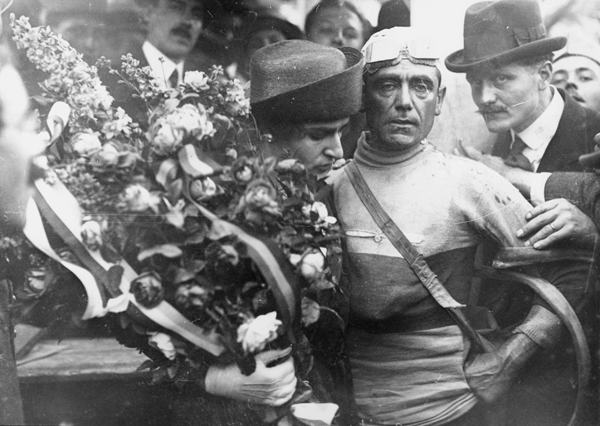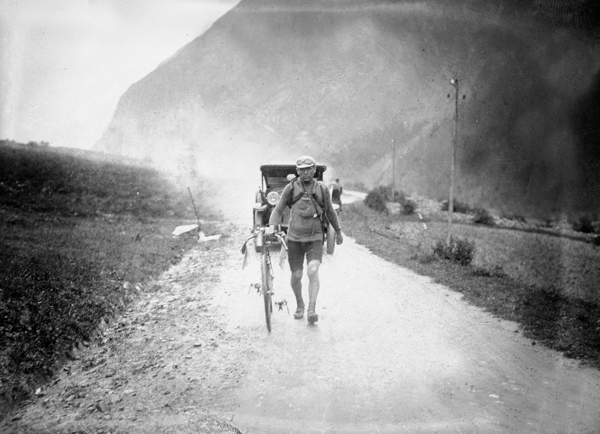 Unless you are a Tour of France fanatic or still ride steel toe clips, the name Eugene Christophe will mean nothing to you. But Christophe is one of those select band of great Tour riders who never actually won it but he is unique in Tour of France history; he was its first wearer of the coveted Yellow Jersey.
Unless you are a Tour of France fanatic or still ride steel toe clips, the name Eugene Christophe will mean nothing to you. But Christophe is one of those select band of great Tour riders who never actually won it but he is unique in Tour of France history; he was its first wearer of the coveted Yellow Jersey.
The debut moment of sport’s most recognisable attire was at the 1919 Tour, the first after the devastation of World War One. Since the race’s inception in 1903 nobody had thought of the idea of having a distinctive jersey to enable riders, race officials and the public to easily identify the race leader. The Tour of 1919 was 5,560kms in length, run over 15 stages, with an average stage length of 370km and despite having bikes with no gears,the route still took in the Pyrenees and Alps. Being the first postwar Tour, everything was in short supply, from frames (melted down and made into armaments) to fabric (turned into grey uniforms for the massive French army.) At the end of the war France was awash with grey fabric and much of it found its way into bicycle racing jerseys. Jerseys were red and grey, blue and grey, grey and grey and so on. During a particularly wet 482km stage down the west coast of France, the race officials were having great difficulty recognising who was who, especially the race leader, Christophe. At the end of the stage the soaked and muddied riders all looked the same, grey! Enter one Monsieur Bauge, a race official who had the game-changing idea of requiring the race leader to have a jersey that was instantly recognisable. When the opportunity arose that evening, M. Bauge approached race ‘boss’ Henri Desgrange with the idea. Desgrange embraced the idea at once and chose a simple yellow design, the page colour of L’Auto magazine (the Tour sponsors). Desgrange telephoned his Paris HQ that evening and ordered 10 jerseys to be made and sent to the race ASAP. The first 10 of many Malliot Jaunnes duly arrived at Grenoble in the Alps where still race leader Christophe donned a Yellow Jersey, witnessed by a handful of journalists and spectators. And despite Christophe being unwilling to wear it (apparently spectators began calling him ‘The Canary’), the Legend was born.

Just a few days out from Paris, Christophe had a lead of over 20 minutes from second on GC Fermin Lambot of Belgium. The French were sure Christophe was to win the race that he was to have won, but for bad luck, in 1913. In that year Christophe was on top form and attacked on the Tourmalet leaving the others way, way behind and he, Christophe leader on the road. Then descending the Tourmalet, disaster struck – his front forks snapped and the greatest Tour de France legend, that of Eugene Christophe welding his own forks, was acted out. Christophe went on to finish seventh overall in that Tour, one he should have won.
Fast forward to the penultimate stage of the 1919 race, a 468km slog from Metz to Dunkirk over roads still shell shocked from the war. Still with that handy 20-minute lead, Christophe must have been confident of wearing Yellow into Paris the next day. But the war-battered roads of Northern France showed no mercy for the fist Yellow Jersey wearer, for just outside the town of Valenciennes lightening struck again for Christophe. His front forks broke again. As was the case six years earlier, a rider had to perform his own repairs with no outside help. Christophe again effected his own repairs but it cost him over an hour and his dream of Tour victory the next day.
Things happen in threes so a saying goes, and it’s all too true for Eugene Christophe. During the Tour of 1922 the then 37 year old had held the lead early on, but once the race hit the Pyrenees his legs could not match the pace and he slipped down the GC. While descending the Col de Galibier, Christophe noticed a vibration in his steering, stopping to inspect he discovered, yes, broken forks. Rules had changed and Christophe was able to borrow a bike to finish the stage from a priest.
Christophe never won a Tour but he did have the best time in finishing second in 1912. Unfortunately for him, the Tour that year was decided on a points system much like today’s Green Jersey format. Christophe’s career spanned 23 years, with four years spent as a cycle messenger on the Western Front. He won Milan-San Remo, Paris-Tours and twice the gruelling 578km Bordeaux-Paris. In his final year of racing at the age of 41 he finished 44th in Paris-Roubaix.
His grand misfortunes on the bike turned to his advantage upon retirement. He was feted everywhere he went and his exploits at the blacksmith’s forge in the village of St Marie de Campon at the 1913 Tour will still be written about and discussed a hundred years hence. Christophe had hand made his first toe clips in 1912 and after much development they went into mass production in 1922 and are still to this day manufactured. The innovative mind of Christophe also gave us the forward facing rear dropout and hub wing nuts, which in their day revolutionised rear wheel changes. Eugene Chistophe died in 1970 aged 85, was still riding daily and an avid follower of the sport.

